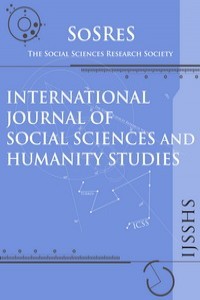BARRIERS TO COMMUNITY PARTICIPATION IN CRIME PREVENTION IN LOW INCOME COMMUNITIES IN CAPE TOWN
BARRIERS TO COMMUNITY PARTICIPATION IN CRIME PREVENTION IN LOW INCOME COMMUNITIES IN CAPE TOWN
Community participation, crime, crime prevention, neighborhood watch, Khayelitsha township Cape Town,
___
- Achmat, Zackie. 2014. “Apartheid geography and murder in Cape Town.” geography-and-murder-cape-town_2297.
- Bernard, H. Russell. 2002. Research Methods in Anthropology:
- Qualitative and quantitative methods. 4th Ed. Toronto: Altamira Press. Botterill, Linda Courtenay and Melanie Fisher. 2002. “Magical thinking: the rise of the community participation model”. Paper presented at the Jubilee Conference of Australian Political Studies
- Association, Australian National University, Canberra. October http://www.researchgate.net/publication/251381796_Magical_thinki ng_The_rise_of_the_community_participation_model> .
- Brown, Kay V. 2001. “The determinants of crime in South Africa”.
- The South African Journal of Economics 69(2): 269-299. Carcach, Carlos and Cathie Huntley. 2002. Community participation and regional crime. Australian Institute of Criminology Trends &
- Issues in Crime & Criminal Justice No. 222. http://www.aic.gov.au/media_library/publications/tandi_pdf/tandi222 pdf . Centre for the Study of Violence and Reconciliation (CSVR). 2009.
- Why does South Africa have such high rates of violent crime? http://www.csvr.org.za/docs/study/7.unique_about_SA.pdf. City of Cape Town. 2009. “Khayelitsha urban upgrading programme launched.” https://www.capetown.gov.za/en/Pages/Khayelitshaurbanupgradepro grammelaunched.aspx.
- Fagan, Jeffrey and Tracy L. Meares. 2008. “Punishment, deterrence and social control: the paradox of punishment in minority communities.” Ohio State Journal of Criminal Law 6: 173-229
- Faull, Andrew. 2007. Corruption and the South African Police
- Service: a review and its implications. Paper 150, Institute for Security Studies (ISS). Faull, Andrew. 2011. Corruption in the South African Police Service:
- Civilian Perceptions and Experience. Paper 226, Institute for Security Studies (ISS). Fleissner, Dan and Fred Heinzelmann. 1996. Crime Prevention
- Through Environmental Design and Community Policing. National Institute of Justice, US Department of Justice, Office of Justice Programs. http://www.ncjrs.gov/pdffiles/crimepre.pdf. Friedman, Warren. 1998. “Volunteerism and the decline of violent crime.” Journal of Criminal Law & Criminology 88(4): 1453-74.
- Guarte, Jacqueline M. and Erniel B. Barrios. 2006. “Estimation under purposive sampling.” Communications in Statistics Simulation and Computation 35(2): 277-284.
- Kane, Robert J. 2005. “Compromised police legitimacy as a predictor of violent crime in structurally disadvantaged communities.” Criminology 43(2): 469-498.
- Lancaster, Lizette. 2013. “Crime stats: where murder happens in
- South Africa.” Mail & Guardian. http://mg.co.za/article/2013-09-19- where-murder-happens-in-south-africa.
- Leuvennink, Jaco. 2015. “Nene: Fighting crime and defense a priority.” defence-a-priority-20150225.
- Liebermann, Susan and Justine Coulson. 2004. “Participatory mapping for crime prevention in South Africa – local solutions to local problems.” Environmental and Urbanisation 16(2): 125-134.
- Manaliyo, Jean Claude. 2014. “Townships as crime ‘hot-spot’ areas in Cape Town: perceived root causes of crime in Site B,
- Khayelitsha.” Mediterranean Journal of Social Sciences 5(8): 596- Marshall, Bryan, Peter Cardon, Amit Paddar, and Renee Fontenot. “Does sample size matter in qualitative research?: a review of qualitative interviews in IS research.” Journal of Computer Information Systems 54(1): 11-22. Mbola, Bathandwa. 2009. More Spending on Crime Prevention Yields spending-crime-prevention-yields-results.
- Newham, Gareth. 2005. A Decade of Crime Prevention in South
- Africa: From a National Strategy to a Local Challenge. Centre for the Study of Violence and Reconciliation (CSVR). http://www.csvr.org.za/docs/crime/decadeofcrime.pdf. Pattavina, April, James M. Byrne, and Luis Garcia. 2006. “An examination of citizen involvement in crime prevention in high-risk versus low-to moderate-risk neighborhoods.” Crime & Deliquency (2): 203-231.
- OSAC. 2014. South Africa 2014 Crime and Safety Report. https://www.osac.gov/pages/ContentReportDetails.aspx?cid=15318.
- OSAC. 2015. South Africa 2015 Crime and Safety Report. https://www.osac.gov/pages/ContentReportDetails.aspx?cid=17042.
- Pelser, Eric. 1999. The Challenges of Community Policing in South
- Africa. Occasional Paper No. 42, Institute for Security Studies (ISS). Ramoraka, T. 2013. “Building safer urban human settlements in
- South Africa: a case of the National Development Plan 2030.”
- Journal of Public Administration 48(2): 321-333. Ren, Leng, Jihong Solomon Zhao, Nicholas P. Lovrich, and Michael J. Gaffney. 2006. “Participation community crime prevention: who volunteers for police work?” Policing: An International Journal of
- Police Strategies & Management 29(3): 464-481. Republic of South Africa. 1994. White Paper on Reconstruction and Development. Government Gazette, 23 November 1994.http://gov- zas.websiteinprogress.co.za/sites/www.gov.za/files/16085.pdf .
- Republic of South Africa. 1995. No.68 of 1995: South African Police
- Service Act, 1995. Office of the President, 4 October 1995. http://www.info.gov.za/view/DownloadFileAction?id=70987.
- Republic of South Africa. .2011. Integrated Social Crime Prevention Strategy. http://www.dsd.gov.za/index2.php?option=com_docman&task=doc_ view&gid=217&Itemid=3.
- Republic of South Africa. 2013. HIS Index Confirms Crime Statistics – http://www.sanews.gov.za/south-africa/ihs-index-confirms-crime- statistics-mthethwa.
- Sampson, Robert J. and W. Byron Groves. 1989. “Community structure and crime: testing social disorganization theory”. American
- Journal of Sociology 94(4): 774-802. Scheider, Matthew C., Tawandra Rowell, and Veh Bezdikian. 2003.
- “The impact of citizen perceptions of community policing on fear of crime: finding from twelve cities.” Police Quarterly 6: 363-386. Schönteich, Martin. 1999. Assessing the Crime Fighters: the Ability of the Criminal Justice System to Solve and Prosecute Crime.
- Occasional Paper No. 40, Institute for Security Studies (ISS). Shaw, Mark. 1996. Reforming South Africa’s Criminal Justice
- System. Occasional Paper, No. 8, Institution for Security Studies (ISS). Shaw, Mark. 2002. Crime and Policing in Post-apartheid South
- Africa: Transforming Under Fire. Cape Town: New African Books (Pty) Ltd. Sherman, Lawrence W. 2002. “Trust and confidence in criminal justice”. NIJ Journal 248: 23-31. Simon, Marilyn. http://dissertationrecipes.com/wp-content/uploads/2011/04/Analysis- of-Qualitative-DataXY.pdf.
- Singh, D. 2005. “Restoring to community justice when state policing fails: South Africa.” Acta Criminologica 18(3): 43-50.
- Zhao, Jihong Solomon, Chris Gibson, Nicholas Lovrich, and Michael Gaffney. 2002. “Participation in community crime prevention: are volunteers more or less fearful of crime than other citizens?” Journal of Crime and Justice 25(1): 41-61.
- Başlangıç: 2009
- Yayıncı: Sosyal Bilimler Araştırmaları Derneği
RETENTION OF EDUCATORS: THE ROLE OF LEADERSHIP, EMPOWERMENT AND WORK ENGAGEMENT
P. Serra, J. Surujlal, E. H. Redda
C. M. Mbajiorgu, A. A. Asha, S. O. Mmusi
NOBEL LAUREATE JAMES M. BUCHANAN’S (1919-2013) CONTRIBUTIONS TO POLITICAL ECONOMY
